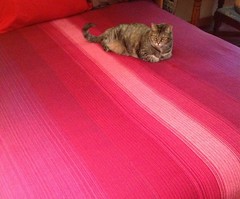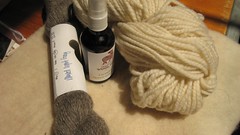Testing
I have been spinning cotton using various tools for a while now, at first against my will and better judgement: who among us needs a new rabbit hole?
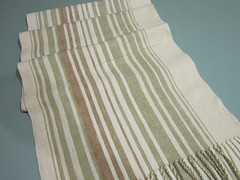
At a Spin-Off Autumn Retreat a few years ago, cotton grower, spinner, and weaver Phreadde Davis handed out small CD spindles and cotton still on the seed, and showed a table full of us how to spin it. It would have been rude to refuse such a kind a generous gesture: Phreadde had come with a pile of spindles for us, the cotton and much enthusiasm! And she is so nice, and so soft spoken, and yes, well, we'd had a glass or two, so, as I said, against my better judgement, I tried it.
Well. That was easy! I said to myself. What's all this fuss about cotton? I said to myself. It must have been the "glass or two" talking. Or maybe the "glass or two" gave me false confidence?
I tried that little spindle a few times at home, less under the influence, and lo! it still worked.
I bought a charkha. That worked too. I got better at it, making small skeins that the charkha's spindle allowed.
But then, Joan Ruane came to our guild, to speak and teach us about cotton, and spinning it on the wheel. I've known Joan over the years, we've met up at various fiber events, but I'd never taken a class from her. I signed up! Cotton Spinning on the Wheel. One Day! What did I have to lose?
She brought us many cottons to try: Pima, Acala, Sea Island, and several of the natural colored cottons. I don't remember the Aha! moment, but something she said clicked for me and I was off spinning cotton:
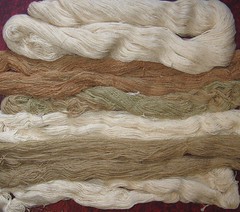
I spun up everything she gave us, and then bought more. I tried (I really did) to keep track of which cotton was which, but with a dizzying array of fiber that all (pretty much) looked the same, I lost that battle.
So I spun and plied All. The. Cottons. I spun cottons that I'd purchased over the years, and some easy spin and natural green cotton given to me by another friend. I plied them all together, somewhat randomly, somewhat by color. I managed keep the Acala Easy Spin I purchased separate from the others, but only because I spun it last, after all the other bobbins were plied up.
I was on a mission. Joan had garments to show us, and as she spoke about them: she spins a soft yarn, softly plied, and setts her fabric a bit more openly than I would. Cotton (like any fiber) can be spun in many different ways, more or less twist, fine or finer (there is no sense in taking a really short fine fiber and trying to spin a fat yarn: it will only degrade with use. Any Use. And I spin to use my yarns. They are the material with which I weave or knit. They are not the end-game. But I digress!).
I knew my cotton yarns would be different than Joan's. I have a way of weaving, a propensity to sturdier fabrics, and I needed to spin, ply and weave a sample fabric before I would know if what I was thinking was actually possible/reasonable, right for me. Every fiber can be spun for a range of uses: cotton from fine lawn to sturdy canvas. Diaphanous gauze, to sailcloth, even! The end use determines the amount of twist, the grist, the finishing process, and whether one plies or not, and if so, how many plies? (oops, there's that digression, again!)
How would the yarn I was spinning behave in fabric? Is there differential shrinkage among the various types of cotton? How would I sett this yarn? What to use as weft? I set up the first length: 16" x 4 yards on the loom. This first woven cotton sample would/could be a scarf or shawl, if all worked well, and if there was differential shrinkage, a scarf would not mind that. So to speak.
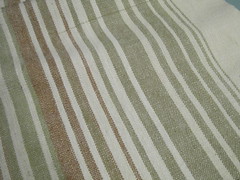
Well. It all worked out just fine: through running the warps, threading and sleying, winding on: no breakage, the yarns just behaved like ...Yarn. I wove it off with whatever skeins I had left: mostly the Acala Easy Spin, but there is at least one skein/bobbin of something else, which shows up a bit here:
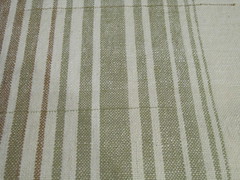
Just above the green inserted weft, you can see where I changed bobbins and the new weft is a slightly heavier grist. I don't know if it is from a different type of cotton or whether I just spun it differently, but it's not a deal-killer by any means, and does not scream out in the finished fabric.
So what did I learn from all this spinning, sampling, testing? Cotton spinning can be easy and fun, and the fabric is pretty darn nice. I am not a big fan of the colored cottons, and will probably spin up what I have and not buy much more of it in the near future. I want to spin more of the white Acala Easy Spin, I want to spin it with slightly more twist, and I want to (gasp, I know) dye it. This white stuff is just not me, and the natural colors? Well, yes, they are pretty. They are interesting because they bring color without dyeing. But for me? I want more color. I just might have to (gasp!) over-dye this 1st sample cotton fabric....time will tell.
And, best of all, I know exactly what I want to do for my next sample fabric.
So thanks Phreadde, thanks Diane, and many many many thanks to Joan. Rabbit hole? Here I come.

At a Spin-Off Autumn Retreat a few years ago, cotton grower, spinner, and weaver Phreadde Davis handed out small CD spindles and cotton still on the seed, and showed a table full of us how to spin it. It would have been rude to refuse such a kind a generous gesture: Phreadde had come with a pile of spindles for us, the cotton and much enthusiasm! And she is so nice, and so soft spoken, and yes, well, we'd had a glass or two, so, as I said, against my better judgement, I tried it.
Well. That was easy! I said to myself. What's all this fuss about cotton? I said to myself. It must have been the "glass or two" talking. Or maybe the "glass or two" gave me false confidence?
I tried that little spindle a few times at home, less under the influence, and lo! it still worked.
I bought a charkha. That worked too. I got better at it, making small skeins that the charkha's spindle allowed.
But then, Joan Ruane came to our guild, to speak and teach us about cotton, and spinning it on the wheel. I've known Joan over the years, we've met up at various fiber events, but I'd never taken a class from her. I signed up! Cotton Spinning on the Wheel. One Day! What did I have to lose?
She brought us many cottons to try: Pima, Acala, Sea Island, and several of the natural colored cottons. I don't remember the Aha! moment, but something she said clicked for me and I was off spinning cotton:

I spun up everything she gave us, and then bought more. I tried (I really did) to keep track of which cotton was which, but with a dizzying array of fiber that all (pretty much) looked the same, I lost that battle.
So I spun and plied All. The. Cottons. I spun cottons that I'd purchased over the years, and some easy spin and natural green cotton given to me by another friend. I plied them all together, somewhat randomly, somewhat by color. I managed keep the Acala Easy Spin I purchased separate from the others, but only because I spun it last, after all the other bobbins were plied up.
I was on a mission. Joan had garments to show us, and as she spoke about them: she spins a soft yarn, softly plied, and setts her fabric a bit more openly than I would. Cotton (like any fiber) can be spun in many different ways, more or less twist, fine or finer (there is no sense in taking a really short fine fiber and trying to spin a fat yarn: it will only degrade with use. Any Use. And I spin to use my yarns. They are the material with which I weave or knit. They are not the end-game. But I digress!).
I knew my cotton yarns would be different than Joan's. I have a way of weaving, a propensity to sturdier fabrics, and I needed to spin, ply and weave a sample fabric before I would know if what I was thinking was actually possible/reasonable, right for me. Every fiber can be spun for a range of uses: cotton from fine lawn to sturdy canvas. Diaphanous gauze, to sailcloth, even! The end use determines the amount of twist, the grist, the finishing process, and whether one plies or not, and if so, how many plies? (oops, there's that digression, again!)
How would the yarn I was spinning behave in fabric? Is there differential shrinkage among the various types of cotton? How would I sett this yarn? What to use as weft? I set up the first length: 16" x 4 yards on the loom. This first woven cotton sample would/could be a scarf or shawl, if all worked well, and if there was differential shrinkage, a scarf would not mind that. So to speak.

Well. It all worked out just fine: through running the warps, threading and sleying, winding on: no breakage, the yarns just behaved like ...Yarn. I wove it off with whatever skeins I had left: mostly the Acala Easy Spin, but there is at least one skein/bobbin of something else, which shows up a bit here:

Just above the green inserted weft, you can see where I changed bobbins and the new weft is a slightly heavier grist. I don't know if it is from a different type of cotton or whether I just spun it differently, but it's not a deal-killer by any means, and does not scream out in the finished fabric.
So what did I learn from all this spinning, sampling, testing? Cotton spinning can be easy and fun, and the fabric is pretty darn nice. I am not a big fan of the colored cottons, and will probably spin up what I have and not buy much more of it in the near future. I want to spin more of the white Acala Easy Spin, I want to spin it with slightly more twist, and I want to (gasp, I know) dye it. This white stuff is just not me, and the natural colors? Well, yes, they are pretty. They are interesting because they bring color without dyeing. But for me? I want more color. I just might have to (gasp!) over-dye this 1st sample cotton fabric....time will tell.
And, best of all, I know exactly what I want to do for my next sample fabric.
So thanks Phreadde, thanks Diane, and many many many thanks to Joan. Rabbit hole? Here I come.
